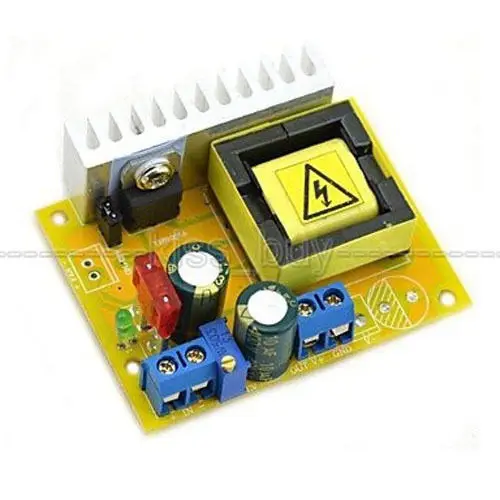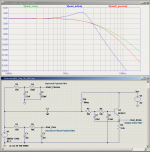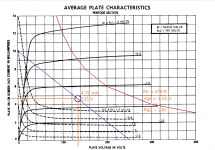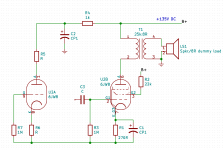We have had a few threads where the OP's were interested in output tube distortion, one asked it to go to a pedal. So how about a pair of 6AK6's driven by a 12AX7? Using a 12V laptop supply which supplies the heaters and a step up module for the high voltage. The speaker can just be a resistor and a pot used to send the signal to the next device. Should have no preamp distortion. Or maybe should go Paraphase? Hmmm...


Looks good!
And the 6ak6 has the highest output power/ filament current I know!
Only 150mA for 1 W!
This one would probably have almost 2W. Would you mic it or use the signal at the speaker and reduce it to line levels?
And the 6ak6 has the highest output power/ filament current I know!
Only 150mA for 1 W!
This one would probably have almost 2W. Would you mic it or use the signal at the speaker and reduce it to line levels?
I was thinking of doing the line level, pick a good load value that will give you the distortion characteristic you want.
So the idea here is to have power amp distortion in a pedal? How is this possible with only 12v? I’ve seen 12ax7 pedals but they are at low voltage and don’t make use of the tube properly due to the low voltage?
Is this any different than a Herzog? What about using one of those voice coils dummy loads Weber used to sell?
A Herzog is a Champ, I suggested an AC-4 but the amp is single ended. This is Class AB push-pull, the only question mark is the output transformer. I have a few suitable ones but they are not readily available. I have some 70V transformers I may try. Will it be enough gain? May need a FET up front to warm up the signal, or another pedal. I just wanted to put together the simplest circuit that may be up to the job. Could go two Self-Split if more gain is needed, I hope not.
You can get a PP 10k transformer for $16 with multiple primary and secondary taps.
Spec sheets are saying 10% distortion in class a SE. I think that might be better. You would have a second triode for gain if needed.
Spec sheets are saying 10% distortion in class a SE. I think that might be better. You would have a second triode for gain if needed.
Thought about that. Actually have an amp sitting around with a Mosfet PI and one 12AX7 driving a pair of 12AQ5's, a 7-pin tube like the 6AK5. With a little rewiring it could work. Or something like this.


Last edited:
I'm looking forward to see what you come up with!...output tube distortion...a pedal...
I got fed up of hauling gear to my weekly jams, so I stopped hauling my electric guitar amp, and for a while I've been playing my electric guitar through my little PA, with a few pedals to sweeten the sound (graphic EQ, delay, reverb, Joyo American Sound for vaguely Fenderish amp emulation, and a speaker emulation filter to remove too-high frequencies. It sounds not-bad with a semi-hollow electric guitar, but I've been missing "toobey" clean tones...a little amp-in-a-pedal might be just the thing.
I was thinking of going even smaller than a pair of 6AK6s - a sort of micro-champ built around a single 6JW8 triode/pentode valve. The pentode has only 1.2 W max plate dissipation, but a little tinkering suggests it will work with a 22k reverb transformer and about 170 V B+ (half-wave-rectified 120V AC.) But a little switch-mode HV supply sounds good, too.
If there isn't enough gain from just the two stages, I could add an additional 6AQ6 if a bit more preamp gain is needed.
I have a 6AQ6, 6JW8, and 22k reverb transformer in the junk-box. I think I even have the little high-voltage switching power supply module. Now if I could just find the time and energy...and forget about all the other not-yet-started projects in the mental queue...
-Gnobuddy
I guess you have already seen this one:
Pedal Amp
it's not mine, but looks interesting. There is even a pdf.
http://koti.japo.fi/~tivahal/Pentodes%20pedal/Dual%20Pentode%20Amp.pdf
I like the idea of using pentodes instead of a 12au7 in the power section.
What about two 6JW8 in PP? With the triode you could have the preamp and PI.
There are small SE designs using the 6AW8A. I guess it is a candidate for a nice PP amplifier.
Pedal Amp
it's not mine, but looks interesting. There is even a pdf.
http://koti.japo.fi/~tivahal/Pentodes%20pedal/Dual%20Pentode%20Amp.pdf
I like the idea of using pentodes instead of a 12au7 in the power section.
What about two 6JW8 in PP? With the triode you could have the preamp and PI.
There are small SE designs using the 6AW8A. I guess it is a candidate for a nice PP amplifier.
I hadn't, thanks for the link! That little amp is beautifully constructed.
I did think about that a little. For single-ended operation, a 22k load looks pretty decent, and an off-the-shelf Fender reverb transformer has about the right impedance; you can also get there using a 70V audio line transformer. A bigger-than-22k load would be nice, but not easy to find.What about two 6JW8 in PP? With the triode you could have the preamp and PI.
For PP, the starting point for the (end-to-end) output transformer primary impedance is twice the SE load. So we need a transformer that is at least 44k end-to-end. This is a problem, because it takes a lot of copper and a lot of iron to get such a high primary impedance, along with sufficient winding inductance to maintain frequency response down to 100 Hz or so. Not surprisingly, I can't find any off-the-shelf push-pull OT with such a high impedance.
So for PP, I think Printer2 has the right idea, going with output valves a bit beefier than the little pentode in the 6JW8. A 6AK6 is happy with a 10k load in SE, and a 22k push-pull OT works for a pair of them. I built an amp like that using a Musical Power Supplies OT5PP output transformer. I know Printer2 built a PP 6AK6 amp as well, using a junked audio line transformer.
The other concern I have is instability. With two triode gain stages in cascade, and a PP output stage, it probably isn't a good idea to have that input triode in the same tiny bottle as one of the output pentodes! Too little distance between them, too much chance of instability because of unwanted feedback through stray capacitance inside the bottle.
I haven't encountered the 6AW8A till now. I'll look up some datasheets later today.There are small SE designs using the 6AW8A. I guess it is a candidate for a nice PP amplifier.
I do have some 6LY8s and 6HZ8s in the junk-box. Both are triode-pentodes. Every now and then I wonder about a miniature "18 watt" amp using just two bottles, with the two triodes used in the long-tailed phase splitter to drive the two output pentodes. (There is the same worry about having too much gain in too small a physical space, though.)
-Gnobuddy
I was thinking of bread boarding the circuit today. I almost got to it a while back but unlike Gnobuddy the snow lays deep here and you have to make the most of the summertime outside. I thought of the gain stage connected to the screen supply. No different than if a LTP is connected to it, no gain from the splitter. But it would not hurt having its own node, I am guessing there will not be much sag given what I intend from the PS. If needed I'll throw another in.The other concern I have is instability. With two triode gain stages in cascade, and a PP output stage, it probably isn't a good idea to have that input triode in the same tiny bottle as one of the output pentodes! Too little distance between them, too much chance of instability because of unwanted feedback through stray capacitance inside the bottle.
I haven't encountered the 6AW8A till now. I'll look up some datasheets later today.
Cool little pedal the guy did. I was thinking of using the 555 circuit and make my own SMPS but when you have a working unit it is hard to bother. Not like I am looking to squeeze into a small area. I have some 7258's, a 12.6V car tube that is equivalent to the 6AN8, another pentode-triode. I have other tubes that would be interesting but I thought I would try this as the 12AX7 is kind of standard and the 6AK6 is easy to drive and to supply to its heaters. I have them and as Gnobuddy said, I managed to use them well enough once before. It is nice to see people thinking out of the box.
What is it about those black Peavey Raptors? I bought one a while ago for $25 with a missing knobs and bridge string saddle. Plug it in and no sound. Nothing I can't fix, just not a high priority as I have a red one that works. But did I think twice when another one was listed for sale? Got it home, black like the other one, like the other one no sound. But all the bits are there except it needs a new nut and a setup. Again, no sound. But for $25...
Brother will be getting the red one, he wants one with a whammy bar.
Brother will be getting the red one, he wants one with a whammy bar.
If I got my paws on a playable $25 solid-body electric guitar, I would remove one of the magnetic pickups, mount a piezo disc in one of the pickup cavities, build a little piezo preamp, and try to make it sound kinda-sorta like an acoustic guitar when plugged in. 🙂Peavey Raptor...no sound...$25
Funnily enough, though I've spent a lot of hours in the Los Angeles area over a period of 24 years, drooling over hundreds of guitars in dozens of music stores big and small, I have never even seen a single Peavey guitar. Not one. 😱
I watched the Peavey episode of Undercover Boss in early 2015, and it was a revelation. If you haven't seen it, it's worth a watch. Wow, what a big stinky mess there is under the Peavey carpet!
Back on topic, if overdriving the little amp-in-a-pedal is the plan, I think some kind of guitar speaker emulation filter will be needed to keep harshness under control.
The simplest one I've found in a commercial product (and probably the least effective) is what's in the Zvex Box Of Rock, two cascaded low-pass filters made with a 10k resistor and 2 nF cap in each stage. The second stage loads down the first badly, and so the frequency response is rather soggy and ineffective at removing high-frequency hash above 5 - 6 kHz.
I'm attaching a screenshot comparing LTSpice simulations of the soggy Zvex filter, a similar (but still soggy) passive filter made with better choice of component values, and a one-transistor active filter.
I adjusted the two improved filter designs to have the same (-3dB) frequency as the original Zvex filter for easy comparison.
The improved passive filter does a little better than the stock Zvex filter, with 3 dB more attenuation at 10 kHz.
The simple active filter is an enormous improvement, with 15 dB more attenuation than the stock Zvex filter at 10 kHz. But it's more complex, and requires its own DC power.
-Gnobuddy
Attachments
I have been wanting to get back to my idea from post #13 of this thread, but work, life, a very sick friend, and other projects have kept me busy.
I do plan to move ahead, though. The attached load-line and initial schematic are what I plan to start with. The schematic is still partial and very much incomplete, with only initial estimated resistance and voltage values for the pentode part of the 6JW8 shown.
Once I get the pentode section working and sounding right, I plan to move on to the triode part of the 6JW8, and develop a working circuit for that too.
The 8 ohm speaker may get replaced by a dummy load and guitar speaker emulation filter for connecting direct to a P.A. system or powered speaker.
While not really designed as a stand-alone guitar amplifier, my rough estimate is that the 6JW8 will deliver approximately 1/4 watt of audio power into the primary of the transformer. Allowing for transformer losses, that might put 200 mW into the speaker, which might still end up being more than loud enough for living-room use, depending on the speaker used!
If driving a speaker with maximum power is the goal, the 6JW8 is certainly capable of more. I picked an easy load line that puts the pentode far below maximum plate dissipation. This is a little small-signal pentode after all, so I assume it was not designed with abuse in mind, the way rugged output valves were.
I think it may also be worth replacing the 25k transformer with a 22k or 27k resistor and doubling the B+ voltage to 270 volts to regain the same operating point. The screen grid supply will be modified so it stays at around 100 volts.
With the transformer removed, the little pentode will not drive a speaker, of course. But the circuit should be able to feed a suitably designed speaker emulation filter, for direct-to-P.A. use.
I have a feeling the transformer will not contribute much to the "real tube amplifier" sound. Time will tell.
-Gnobuddy
I do plan to move ahead, though. The attached load-line and initial schematic are what I plan to start with. The schematic is still partial and very much incomplete, with only initial estimated resistance and voltage values for the pentode part of the 6JW8 shown.
Once I get the pentode section working and sounding right, I plan to move on to the triode part of the 6JW8, and develop a working circuit for that too.
The 8 ohm speaker may get replaced by a dummy load and guitar speaker emulation filter for connecting direct to a P.A. system or powered speaker.
While not really designed as a stand-alone guitar amplifier, my rough estimate is that the 6JW8 will deliver approximately 1/4 watt of audio power into the primary of the transformer. Allowing for transformer losses, that might put 200 mW into the speaker, which might still end up being more than loud enough for living-room use, depending on the speaker used!
If driving a speaker with maximum power is the goal, the 6JW8 is certainly capable of more. I picked an easy load line that puts the pentode far below maximum plate dissipation. This is a little small-signal pentode after all, so I assume it was not designed with abuse in mind, the way rugged output valves were.
I think it may also be worth replacing the 25k transformer with a 22k or 27k resistor and doubling the B+ voltage to 270 volts to regain the same operating point. The screen grid supply will be modified so it stays at around 100 volts.
With the transformer removed, the little pentode will not drive a speaker, of course. But the circuit should be able to feed a suitably designed speaker emulation filter, for direct-to-P.A. use.
I have a feeling the transformer will not contribute much to the "real tube amplifier" sound. Time will tell.
-Gnobuddy
Attachments
Indeed. All depends on how much core saturation you get. Or not. Fred Nachbaur kept the transformer in the small-amp-emulator for his Dogzilla amp.I think it may also be worth replacing the 25k transformer with a 22k or 27k resistor and doubling the B+ voltage to 270 volts to regain the same operating point. The screen grid supply will be modified so it stays at around 100 volts.
... I have a feeling the transformer will not contribute much to the "real tube amplifier" sound. Time will tell.
I was also thinking you could discard half your power and put a 10K transformer in series with a 10K or 15K resistor, which might increase the range of options.
Last edited:
- Status
- Not open for further replies.
- Home
- Live Sound
- Instruments and Amps
- Mini-amp for Output Tube Distortion



